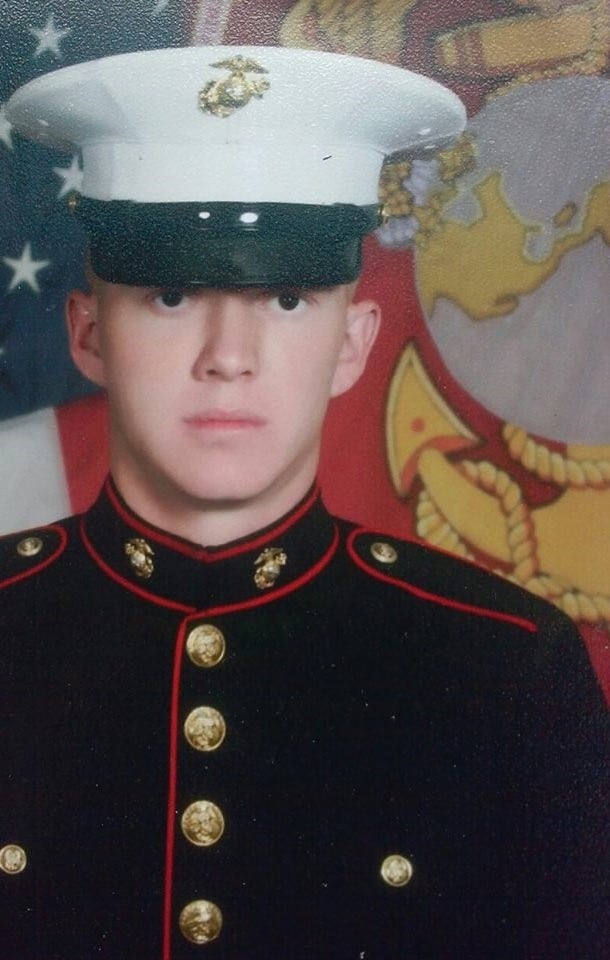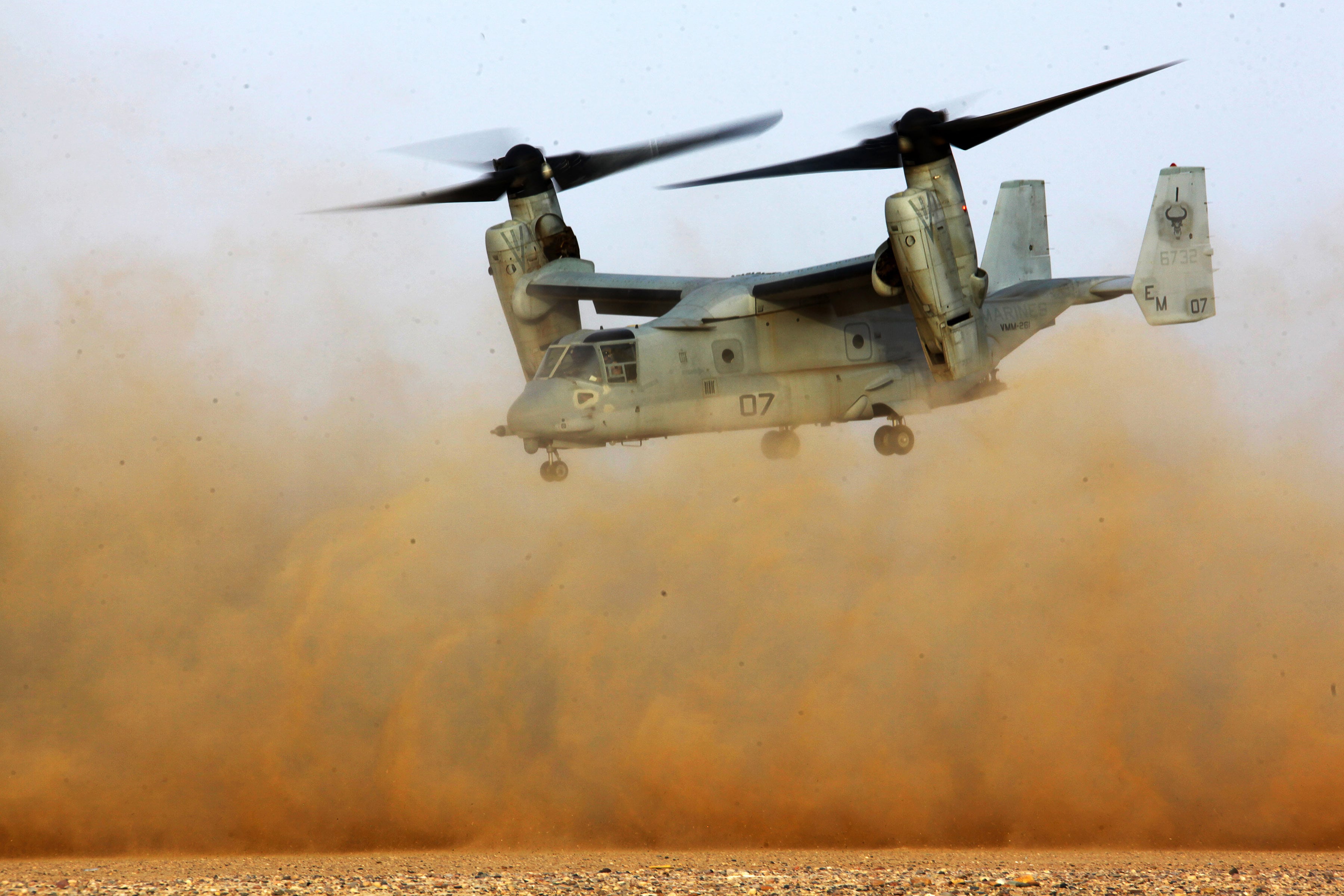The father of one of two Marines killed in an MV-22B Osprey crash last year in Hawaii said he plans to sue Boeing and the other companies that make the aircraft.
Mike Determan told Marine Corps Times that evidence shows the MV-22B is unsafe to fly because sand and dust can get sucked into its engines, causing the aircraft to crash. Military.com first reported about the pending lawsuit and that Determan wants the Marine Corps and Air Force versions of the Osprey to be grounded and eventually replaced by the Bell V-280 Valor.
His son, Lance Cpl. Matt Determan, was killed on May 17, 2015, when the Osprey he was flying in crashed while landing in low-visibility conditions. Lance Cpl. Joshua Barron was also killed.
"Due to the fact this aircraft cannot do what it is designed to do (insert troops in forward operating LZ’s [landing zones] without concrete tarmacs or runways without great risk) our suggestion is to re-purpose this aircraft if they absolutely have to use it or ground it again until the third generation the Valor comes online with all inherent problems worked out," Determan told Marine Corps Times in an email.
There will always be inherent risk in combat aviation, said Capt. Sarah Burns, a Marine Corps spokeswoman, due to the "expeditionary nature" of Marine operations and missions.
"The Marine Corps is committed to ensuring our aircraft are safe, and that the pilots and aircrew who fly them are thoroughly trained," she said.

Lance Cpl. Matt Determan, a 21-year-old infantry rifleman with 3rd Battalion, 1st Marines, died following a May MV-22B Osprey crash in Hawaii.
Photo Credit: Marine Corps
His son, Lance Cpl. Matt Determan, was killed on May 17, 2015, when the Osprey he was flying in crashed while landing in low-visibility conditions. Lance Cpl. Joshua Barron was also killed.
Investigators determined that the Osprey’s left engine aircraft stalled last May because it had sucked in sand, dust and other debris. As a result, Naval Air Training and Operating Procedures Standardization recommended that Ospreys spend no more than 35 seconds trying to land in reduced visibility conditions, down from the initial recommendation of 60 seconds.
The investigators also determined the Osprey’s pilots were partially at fault for the crash because they did not choose another landing site. That does not sit well with Determan, who credits the aircrew’s actions for saving the lives of 20 of the 22 Marines onboard.
"We are infuriated at the Pentagon for attempting to find the aircrew responsible for this crash in an attempt to cover up its many shortcomings while landing and taking off in brownout conditions," he said in the email. "Careers, reputations and lives should not be ruined because of the many inherent problems with this aircraft."
A spokesman for Boeing deferred questions about the Osprey's performance in sandy and dusty environments to Navy and Marine Corps officials.
The V-22 Joint Program Office is looking at a number of ways to reduce the amount of debris that Osprey engines ingest, including improvements to engine air the filters to air coming into the engines and the particle separator that expels debris through a set of blowers, said Billy Ray Brown, a spokesman for Naval Air Systems Command.
The office is also working to develop new alerts and indications to warn Osprey crews about the risk of rapid power loss, Brown said Thursday in an email to Marine Corps Times.
"Using this system, the crew will be made aware of the engine risk and be able to make a decision of landing immediately, waving off, or recovering to a hard surface," he said.
Meanwhile, the office is testing just how susceptible Osprey engines are to damage from sand so that the engines can be improved, Brown said.
"The eventual solution will not be single faceted, but rather a combination of these and perhaps others" he said.U.S. Navy Naval Systems Command is looking at solutions to reduce how much debris V-22 engines ingest, said Marine Corps spokeswoman Capt. Sarah Burns. "The improved inlet solution (IIS), engine monitoring, improved Engine Air Particle Separator, and improved procedures are all possible solutions that are being explored" Burns said in an email. "They are all being looked at to reduce particle ingestion."

An MV-22 Osprey with Marine Medium Tiltrotor Squadron 261 (Reinforced), 24th Marine Expeditionary Unit, lifts off at Udairi Range in Kuwait, July 29, 2012, as part of a live-fire event.
Photo Credit: Cpl. Michael Petersheim, 24th Marine Expeditionary Unit
While investigators found the MV-22B pilots partially at fault for the May 17, 2015 crash, they also determined that the pilots pilots did not violate any regulations or flight standards, Burns said Capt. Sarah Burns, a spokeswoman for the Marine Corps.
"The loss of life was tragic and felt deeply in the Marine Corps community; our thoughts go out to the families of all those affected by this incident," she Burns said in an email.
Determan made clear that he holds the Marine Corps in the highest regards.
"The Marine Corps was the best thing that ever happened to our son," he said. "We are very proud to be Gold Star Members of the Marine Corps family."
Yet the MV-22B Osprey is "the worst thing ever to happen" to his son, said Determan, who added he is worried about the safety of Marines who have to fly in the tiltrotor aircraft Ospreys.
"Our service members deserve the best equipment to work with — this aircraft is far from the best," he said.



